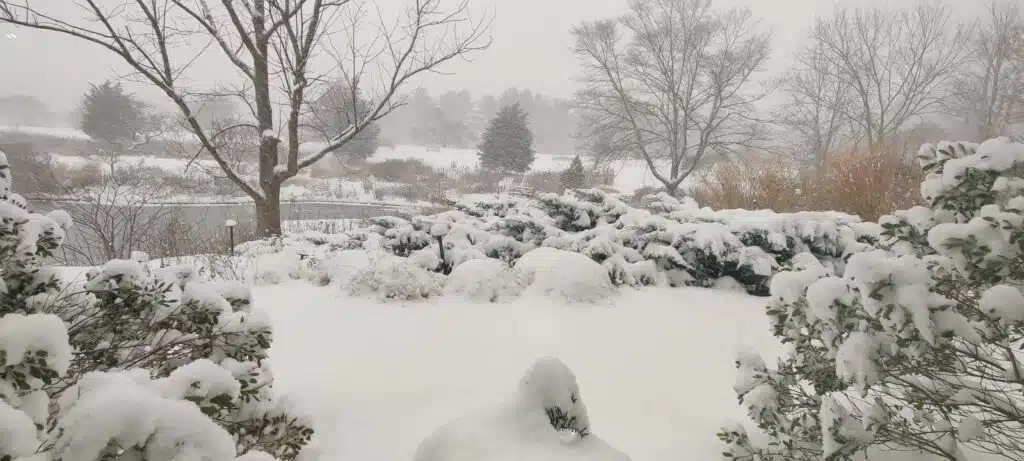Snow and Dormancy: A Delicate Balance Threatened By Climate Change
December 6, 2023

As winter blankets the world in a pristine layer of snow, a silent transformation takes place in the natural world. Snow cover and dormancy are interconnected elements in the delicate dance of our planet’s ecosystems. Understanding this intricate relationship is crucial for appreciating the power in the beauty of winter. But this dance is being altered- by a changing climate.

Why is snow cover important?
The picturesque scenes of snow-covered landscapes evoke a sense of wonder and tranquility. Beyond its aesthetic appeal, snow cover plays a pivotal role in regulating temperatures and supporting biodiversity. Snow acts as a natural insulator, protecting the underlying soil and vegetation from extreme cold temperatures. It also serves as a reservoir of freshwater, gradually releasing it during the spring melt, sustaining rivers and ecosystems.
Dormancy in animals and plants
Many animals, from bears to rodents, enter a state of dormancy known as hibernation during the winter months. Hibernation is a survival strategy to conserve energy when food is scarce and temperatures drop. Animals undergo physiological changes, slowing their metabolic rates and reducing their need for sustenance. Snow cover provides a crucial layer of insulation for these hibernating creatures, shielding them from the harsh winter conditions and temperature fluctuations.
Plants don’t hibernate in the same way animals do, but they still undergo a dormancy process during the winter. As temperatures drop and daylight hours decrease, many plants enter a state of suspended animation, redirecting their energy inward and slowing metabolic processes. Snow cover plays a crucial role in influencing this dormancy. A blanket of snow acts as a protective layer, shielding plants from extreme temperatures and temperature fluctuations. It provides insulation for the soil, preventing it from freezing solid and damaging delicate roots. Additionally, the snow cover helps regulate soil moisture by preventing rapid evaporation.
Climate change’s affect on snow cover and dormancy
However, the balance of snow cover and dormancy is under threat from climate change. Snow is more variable now in many places, including northeast Ohio where instead of a consistent snow cover which used to last potentially for months, we go through multiple freeze melt cycles. This can disrupt the synchronized patterns of hibernation, making animals use more of their stored fat, and impacting the survival of species that rely on specific environmental cues. Insufficient snow cover may expose plants to harsher winter conditions, leading to potential damage and affecting their ability to thrive during the growing season.
As temperatures rise, snow cover becomes less reliable, affecting not only hibernating animals and plants but also the broader ecosystem. Changes in snowmelt patterns can lead to altered water availability, affecting plant growth and the timing of crucial life cycles for various species. While the interconnected web of life, delicately woven over time, is used to adapting to changes, when changes in snowmelt combine with habitat loss, invasive species pressure, and pests and disease, these things in combination can overwhelm individuals or species.
If you want to see how the freezing process and snow cover impacts ecosystems for yourself, pick a place in your yard or near your home. Observe the soil, plants, and any animal life you might see in that area on different days- with snow cover and in melting cycles. Think about how underground roots or burrowing animals might experience these changes in temperature and the other changes you observe.
Snow cover and dormancy are intertwined elements of the natural world, an example of the delicate balance that sustains ecosystems. While snow brings a sense of serenity to winter landscapes and hibernation is a remarkable adaptation, climate change poses a threat to these intricate processes. As stewards of the Earth, it is our responsibility to understand, appreciate, and actively work towards preserving the delicate harmony of our planet’s ecosystems in the face of a changing climate. At Holden, we are monitoring and managing our natural areas and wildlife. If we notice population declines, because of changes in snow cover or other reasons, we try improve species or ecosystem resiliency by managing the ecosystem to provide better habitat. We might not be able to stop the snow from melting, but if we plant more berry bushes, for example, we can provide more food resources to help our wildlife get through a difficult winter. Through collective efforts and awareness, we can strive to protect the beauty and resilience of the natural world for generations to come.

Beck Swab, PhD
Director of Conservation and Community Forestry
An Ohio native, Beck attended the Ohio State University where they received combined bachelors and masters degrees. Beck went on to complete a Ph.D. at the University of California Riverside, studying how plants respond to stressors such as changing fire intervals and climate change in California, Australia, and Denmark. Beck was the Director of Restoration Ecology at The Wilds from 2015-2020. There they gained experience in restoration of a wide variety of ecosystem including prairies, forests, and wetlands. Currently the Director of Conservation & Community Forestry at Holden Forest and Gardens, Beck’s goal is to serve as a bridge between conservation managers, researchers, policy makers, and the public to improve conservation efforts.













